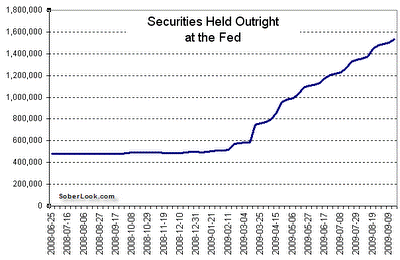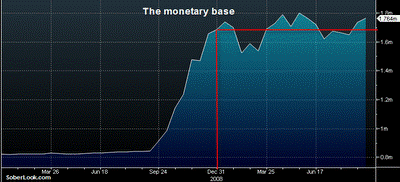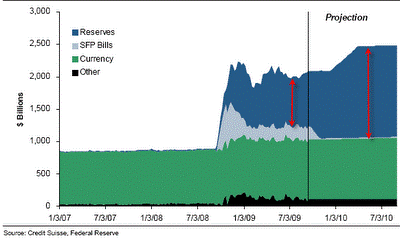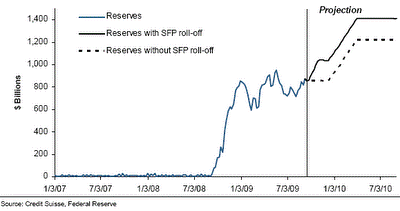US Quantitative Easing has Just Begun
Location: Tokyo
Author:
Walter Kurtz
Date: Thursday, September 24, 2009
With the FOMC meeting done, it's worth reflecting on the Fed's
implementation of the monetary policy this year. Surprisingly, according
to the latest Credit Suisse research, there hasn't been much
quantitative easing in 2009. But how could that be possible, given the
way the Fed has been growing its balance sheet? The chart below shows
securities held outright by the Fed. How can this NOT be a form of
quantitative easing?

Credit Suisse argues is that the monetary base has not really grown much
in 2009, as the following chart shows.

Source: Bloomberg
So where is all the cash going from the Fed's purchases? It has to end
up in the banking system and show up in the monetary base. The argument
Credit Suisse makes is that all the short-term lending the Fed had put
in place last year as an emergency measure has been shrinking in size,
effectively offsetting the securities purchases.

Banks are de-leveraging, trying to reduce their borrowing from the Fed.
Effectively securities purchases put Fed’s money with the banks, while
the banks in turn pay back the Fed on their loans, thus neutralizing the
impact. As we discussed before, this has
slowed down the pace of the Fed's balance sheet growth
significantly.

In addition some of the cash for the Fed's recent lending had come from
the SFP program in which the US Treasury has issued treasury bills with
the proceeds to be used by the Fed for its emergency lending. That type
of program does not add any new cash to the system, because while the
Fed injects cash (by lending to banks, etc.), the Treasury takes the
liquidity out by selling bills. That in fact was the original purpose
for SFP.
But SFP is expected to be wound down shortly. The impact of the
reduction in short-term funding facilities will end as the programs come
to a close. Therefore there will be nothing more to offset securities
purchases going forward. That means that if the Fed continues purchasing
paper at it's recent pace, quantitative easing finally will kick in with
force.

This will end up ballooning bank reserves and truly “flooding” the
system with dollars. The chart below from Credit Suisse shows their
projection for reserves (translating into a rapidly rising monetary
base):

The Fed is keenly aware of this problem going forward, particularly with
the dollar weakness. Once SFP as well as the short-term facilities wind
down, every dollar of purchased securities will be a new dollar
“printed”. That is why the Fed is now
supposedly putting together a new securities reverse repo program
with the dealers. The idea is that going forward the Fed will be buying
new securities by borrowing money from the dealers rather than
“printing” new dollars. The Fed will place its securities with the
dealers as collateral when it borrows. In fact the central bank may
choose to borrow against the existing securities as well. New security
purchases will be putting liquidity into the system, but by borrowing
from the dealers, the Fed will be temporarily taking liquidity out.
Eventually the Fed will have to outright sell the trillion plus of securities it holds, taking liquidity out permanently (the reversal of quantitative easing) – a dangerous thing to do in this economy. And the more purchases it makes going forward, the harder on the economy it will be to reverse it. For now however, the reverse repo effort will have to do, by (at least in part) compensating for the wind down of SFP and the short-term emergency lending programs.
This briefing is provided as general information, and does not constitute definitive advice or recommendations. Any views expressed in the above articles are those of the author concerned and do not necessarily reflect the views of RiskCenter or any other party. Please send any comments or queries to feedback@soberlook.com.

To subscribe or visit go to: http://www.riskcenter.com